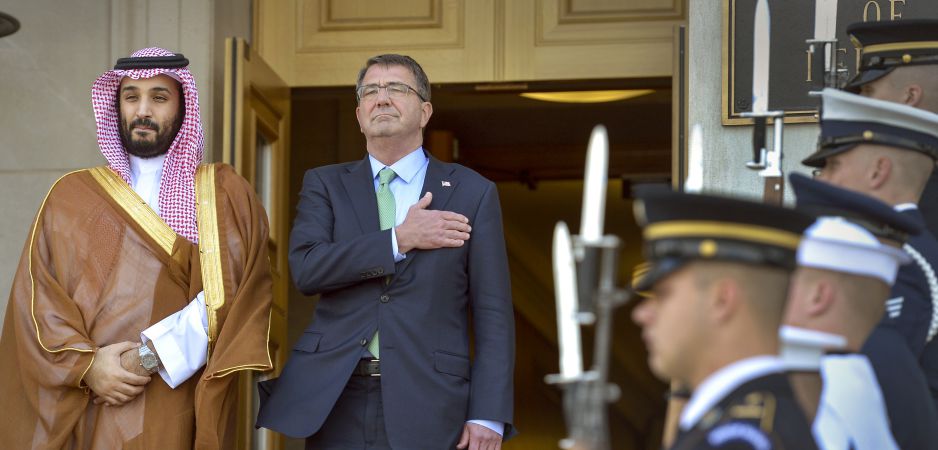The Saudi-led fight against Houthi rebels in Yemen will lead to irreversible consequences for the stability of the country and its people.
Six months after a Saudi-led coalition launched an offensive against Shiite Houthi rebels, it is difficult to conceive how the situation on the ground in Yemen has improved. The collateral damage caused by the onslaught has been colossal and potentially irreversible.
Yemeni civilians have never been as vulnerable as they are now. The war has created a humanitarian crisis that has not only left them terrorized in the crossfire, but also vulnerable to the rise of radical Islamist actors who have taken advantage of the ensuing power vacuum. If the war continues, there is little prospect of a peaceful end to the conflict.
After the Iran-aligned rebels seized the capital Sanaa in November 2014, the Saudis feared a total Shiite takeover of Yemen. In the first month-long military campaign dubbed “Operation Decisive Storm,” Saudi Arabia launched airstrikes on Houthi targets primarily in their strongholds of Sanaa and Aden, in hope of forcing their complete withdrawal and restoring the ousted President Abd Rabbuh Mansour Hadi to power.
The coalition has continued to bombard Yemen vis-á-vis airstrikes, and now an Emirati and Qatari ground invasion has followed in what was supposed to be a “limited” military operation. The outcome has been catastrophic for the stability of Yemen and its people.
Water Crisis in Yemen
The humanitarian crisis created by the war is staggering in even the tumultuous history of the small Arab state. According to the United Nations (UN), the conflict has left nearly 2,000 Yemeni civilians dead—half of the total death toll.
This should not come as a surprise. In the first month of Operation Decisive Storm, the Saudi-led coalition’s targets included a village, market, multiple schools, a mosque, health facility and dairy factory. The coalition has showed an extreme disregard toward civilian life, especially Shiites. It has purposely targeted Shiite Yemenis—the Zaydis—for simply belonging to the same Islamic sect of the Houthis. The concentration of airstrikes have taken place in the Zaydi-dominated Saada province in the north, far removed from the Houthi-occupied Sanaa and Aden, which evidences the coalition’s malicious intent to punish the entire Zaydi population for the Houthis’ actions.
The UN also claims that the area with the most egregious access constraints for humanitarian assistance is in Saada, whose residents have essentially been put in a chokehold by Riyadh. Although the Saudi-led, Sunni Arab-dominated coalition claims the goal is to transfer power from the Houthis to the former government, its actions have demonstrated a clear desire to weaken the Shiite population in order to guarantee that Yemen remains in the hands of its Sunni allies.
Yemeni civilians have not only been caught in-between the clashes. They also suffer from a water crisis that preceded the conflict long ago. Before the Saudi-led “intervention” against the Houthis, 13 million Yemenis lacked access to clean water. Now, Oxfam reports that in the past few months alone, a further 3 million Yemenis are without water as a direct result of the war. That leaves a total of two-thirds of the population, or 16 million, without access to clean water.
Consequently, Yemenis have been forced to rely primarily on trucks to transport water. However, the control of maritime traffic by the Saudi-led coalition has prevented commercial goods from entering the country, which has adversely led to fuel shortages. As a result, the price of water has quadrupled in some areas. Not only did Yemen face a shortage of natural water, but now Yemenis struggle to have safe access to water or even afford it.
Here Comes the Islamic State
The humanitarian crisis sparked by the war is, and will continue to be, disastrous for the Yemeni people. However, equally a threat for the future stability of the country is the rise of radical Islamist groups, including al-Qaeda in the Arabian Peninsula (AQAP) and the even more draconian Islamic State (IS).
The latest conflict has rendered years of US drone strikes on AQAP strongholds useless and has ultimately reinvigorated the terrorist group. One month after the Saudi-led offensive began, AQAP took advantage of the deteriorating security situation and freed hundreds of its members in a mass jailbreak in the northeast.
AQAP, however, is less interested in bringing down the Houthis than it is in gathering support. One strategy it has taken is by sharing power with those it has either liberated or protected from the Houthis. In the city of al-Mukalla, Ben Hubbard from The New York Times reports, AQAP only maintained control of one police station after chasing Houthi rebels out. It fostered the creation of a civilian council and provided it with a budget to run the city instead of capitalizing on the opportunity to expand its power. Locals consequently began to view AQAP as a savior, not an enemy.
The Islamic State has similarly capitalized on the Saudi-led war against the Houthis. Prior the Houthi takeover, IS was virtually nonexistent in Yemen. The group paved the road of sectarianism when four of its members burst into two Shiite mosques strapped with explosives in Sanaa and blew themselves up, leaving 137 worshippers dead.
IS continues to launch attacks throughout the country that target Zaydi Shiites, not just Houthi rebels, in hope of exasperating the sectarian divide. While the resurgence of AQAP has predominantly taken place in the south, IS has begun to grow in the north. The Islamic State has resorted to arming and recruiting local tribesmen to join its fight against Shiites.
A new crisis could emerge as the two terrorist organizations expand into central Yemen and compete for support among the locals, which would not only jeopardize the country’s security even further, but also make the conflict that much more complicated and difficult to resolve. Additionally, what is significant about the rise of these Islamist actors is how it posits the United States and the Saudi-led coalition on the same side of its traditional adversaries: al-Qaeda and the Islamic State.
Tribal Warfare
Another consequence that has been relatively overlooked and could shatter Yemen’s historical tribal system is the arming of Yemeni tribesmen by the Saudi-led coalition. After the launch of Operation Renewal of Hope—the ground operation—Riyadh began flying in hundreds of tribesmen from southern Yemen to Saudi Arabia to train and provide them with light arms.
These Yemenis have proved to be a formidable force against the Houthis because of their familiarity with the terrain and support among locals—many of whom are skeptical of the foreign coalition. Arming them could have dire consequences.
First, considering both IS and AQAP’s growing support from these groups, it would be unlikely that some of these weapons provided by Saudi Arabia would not end up in the hands of these radical Islamist groups—whether voluntarily handed over, coerced or forced.
Second, these tribes, which have historically practiced nonviolent methods of mediating disputes, will now have weapons that they could use as leverage against weaker and unarmed tribes. The southern tribesmen could potentially use their arms to launch a stronger military campaign to secede from Yemen, which they have wanted for decades. Their training and armament could be a game-changer in their movement for secession.
Yemen has struggled under decades of turmoil. The latest war launched by the Saudi-led coalition has only deepened the fragile state’s preexisting struggles and could leave behind irreversible damage. The rise of the Islamic State and the resurrection of al-Qaeda in the Arabian Peninsula will continue to pose a major threat to Yemen’s security even after the inevitable ouster of the Houthis from power.
However, the likely destruction of past, present and future peace talks between the rival political groups could have an even more disastrous outcome: the lack of a unified government to resolve these issues in a post-war Yemen. Now that the Houthis have grown power-hungry as they slowly expand their territory and that sectarianism has peaked, there is little prospect of any power-sharing arrangement being made.
The current conflict could have been entirely avoided, and Yemen could have been facing a transitional period of a new unified government instead of being dragged through yet another war. According to Jamal Benomar, the former UN envoy to Yemen, a peace deal between the Houthis and warring factions was near to being reached before the Saudi airstrikes began. It is difficult to imagine one being made under the current circumstances, especially with the shadow of Yemen’s overpowering neighbor: Saudi Arabia.
The views expressed in this article are the author’s own and do not necessarily reflect Fair Observer’s editorial policy.
Photo Credit: Glenn Fawcett / Department of Defense
 We bring you perspectives from around the world. Help us to inform and educate. Your donation is tax-deductible. Join over 400 people to become a donor or you could choose to be a sponsor.
We bring you perspectives from around the world. Help us to inform and educate. Your donation is tax-deductible. Join over 400 people to become a donor or you could choose to be a sponsor.
Support Fair Observer
We rely on your support for our independence, diversity and quality.
For more than 10 years, Fair Observer has been free, fair and independent. No billionaire owns us, no advertisers control us. We are a reader-supported nonprofit. Unlike many other publications, we keep our content free for readers regardless of where they live or whether they can afford to pay. We have no paywalls and no ads.
In the post-truth era of fake news, echo chambers and filter bubbles, we publish a plurality of perspectives from around the world. Anyone can publish with us, but everyone goes through a rigorous editorial process. So, you get fact-checked, well-reasoned content instead of noise.
We publish 2,500+ voices from 90+ countries. We also conduct education and training programs
on subjects ranging from digital media and journalism to writing and critical thinking. This
doesn’t come cheap. Servers, editors, trainers and web developers cost
money.
Please consider supporting us on a regular basis as a recurring donor or a
sustaining member.
Will you support FO’s journalism?
We rely on your support for our independence, diversity and quality.







